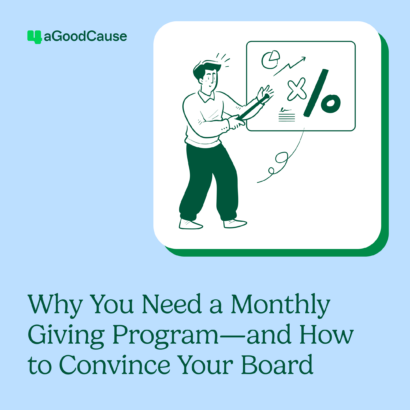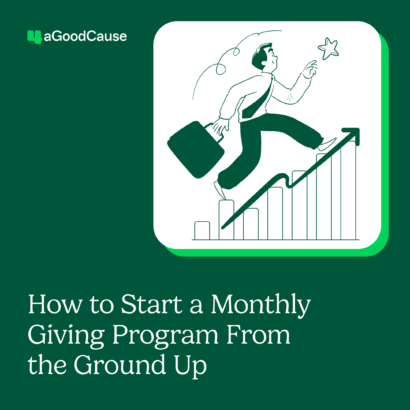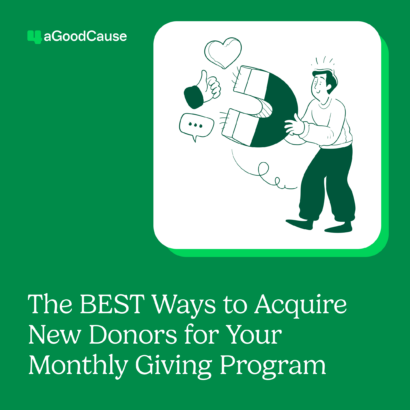Are your nonprofit’s fundraising efforts leaving your team feeling fried? If you’re noticing signs of burnout among your staff, it’s time to reassess your fundraising strategies.
Many charities make the mistake of depending too much on one-off donations and major fundraising events while overlooking the critical need to keep existing donors engaged.
In fact, so much staff and volunteer time is invested in running new campaigns that it’s a challenge to keep up with existing donors and maintain meaningful connections.
This not only strains your staff but also puts your organization’s future at risk.
In this post, I’ll dig into:
By shifting the focus towards sustainable practices like monthly giving, you can alleviate stress on your team, enhance donor engagement, and secure a more reliable revenue stream. (I’ll also cover how monthly giving prevents fundraising fatigue on your staff and donor fatigue.)
The top fix for nonprofit fundraising fatigue: Recurring giving programs
I’m going to walk you through how and why monthly giving (aka recurring giving) solves for fundraising burnout in-depth below, but if you’re short on time, here’s what you need to know:
- 50% of recurring donors give additional gifts. That multiplies the impact of your monthly giving program and any work your team puts in.
- A typical monthly donor’s lifetime value (LTV) is around $7,604 on average. And the best part? You don’t need to run after donors like you’re trying to beat the fastest person at your annual fun run to make this happen.
- Donor retention rates are higher—from 77% up to 90% (depending on the the study).
- New donor acquisition can often cost 10 to 20 times that of recurring donor renewals. And it’s easier to start, run, and manage a high-quality monthly giving program than you think. (Especially with our Monthly Giving Toolkit.)
- 31% of online revenue for nonprofits came from monthly giving in 2024. (And according to M+R Benchmarks, if long-term trends continue, it’s likely that percentage will only increase.)
With those numbers, it’s crazy to argue that your org shouldn’t have a monthly giving program. Especially if you have access the right tools to run it smoothly and easily.
If you’re already familiar with the signs of fundraising burnout—or if you’re sure it’s already found it’s way into your org—jump ahead to the section that covers how to avoid fundraising burnout with the power of monthly giving more in depth.
Signs of fundraising burnout in the nonprofit sector
Burnout is a real issue among nonprofits, with nearly half of U.S. organizations facing it. And it’s one of the top three priorities nonprofit organizations plan to address, according to the 2025 Nonprofit Employee Benefits Survey Report.
Fundraising fatigue is a serious concern that affects not only individual well-being but also the overall organization.
The constant grind of securing new, one-time donations fuels exhaustion. Here’s how to know it’s impacting your team morale.
- Your team feels the constant stress of one-time donations.
- There’s no energy left for donor engagement.
- The creative drive of your fundraising team has stalled.
- You notice less enthusiasm, more compassion fatigue, or work-life balance hangups.
- Classic event-based fundraising isn’t meeting your fundraising goals.
💡 Fun fact: All donor tips through 4aGoodCause go directly to your organization—not our fundraising platform. Learn what makes 4aGC different than other fundraising platforms.
1. Your team feels the constant stress of one-time donations.
The unpredictable nature of one-time donations can create a sense of financial instability within your org.
Without a steady stream of recurring income, it becomes challenging to make concrete long-term plans and ensure the sustainability of impactful projects.
Imagine trying to build a house on shifting sands—the foundation is never secure, and the structure is in constant jeopardy.
That doesn’t feel so good to your team members (both staff and volunteers), leading to burnout as they struggle to navigate the peaks and valleys of donation influx.
2. There’s no energy left for donor engagement.
Building lasting relationships with donors is the lifeblood of any successful nonprofit organization—and arguably, it’s one of the most enjoyable parts of the job for those of us drawn to working in the nonprofit sector.
However, when the focus is predominantly on one-off contributions and the constant search for new donors, the opportunity for meaningful donor engagement diminishes.
It’s like trying to cultivate a garden by tossing seeds randomly and hoping for the best, rather than tending to each plant with care and attention. Without the cultivation of these relationships, donors may feel disconnected and less inclined to offer continued support.
Not to mention, this lack adds to the stress felt by fundraising staff who are constantly seeking new donations without solidifying existing connections.
It also robs fundraising staff of the joy they feel when making long-term, rewarding, human relationships with donors—contributing to compassion fatigue and mental health burnout. When you’re always chasing end fundraising goals without meaningful connections to funders who care so much about your mission, it’s a cause of stress.
3. The creative drive of your fundraising team has stalled.
Fundraising should be—dare I say it—just as fun as it is essential to accomplishing your mission.
Consider the traditional model of fundraising: a never-ending quest for individual, large sum donations. Each new campaign, each new appeal, demands significant resources—time, energy, and creativity—to capture attention and open wallets.
Think about the sheer amount of cognitive creative work that goes into organizing one fundraising event or one-off campaign.
From conceptualizing the theme, messaging, and securing venues to coordinating logistics, marketing plans, and volunteers, one-off events and campaigns are massive undertakings.
Having your staple campaigns and events that you run every year is just fine, but when the creativity stalls and your team is dragging to come up with new ideas, this is a sign of fatigue.
4. You notice less enthusiasm, more compassion fatigue, or work-life balance hangups.
Are you consistently feeling the pressure to secure that next big check, only to find yourself back at square one a few months later?
Are deadlines frequently missed, or is the quality of work declining? Do you pick up a general sense that your team is overwhelmed?
Your staff might express feelings of frustration, compassion fatigue, or they might question the impact of their efforts.
Physical symptoms like increased stress-related illnesses are also red flags. This isn’t just about feeling tired or increased work-life balance; it’s a deeper emotional, mental, and physical exhaustion that comes from a tiresome cycle.
5. Classic event-based fundraising isn’t meeting your fundraising goals.
Organizing frequent events may seem like the go-to strategy for nonprofits to raise funds, but it comes with its own set of challenges that can lead to fatigue among staff members.
The constant cycle of planning, promoting, and executing events can drain resources, both in terms of time and energy, taking away vital focus from the core mission activities of the organization.
One of the most popular fundraising events for many nonprofits is the annual gala. Large-scale events such as these are fun and raise excellent awareness, but they take up to 500 to 1,500 staff hours to produce and need 8-10 months of prep time. Those staff hours are costly to a nonprofit’s bottom line and take away time spent on donor retention.
Plus, without a focused strategy for donor retention post-event, the impact of the event is usually short-lived. Donors who contribute to events may not feel personally invested in the organization’s mission, leading to difficulty in acquiring follow-on donations.
Ultimately, the pressure to deliver successful events can create a sense of urgency that detracts from the long-term sustainability of the organization’s fundraising efforts. And if you’re pouring a lot of resources into events and still struggle to meet your goals, that’s a red flag.
How monthly giving benefits prevent fundraising fatigue on staff (and donors)
Monthly giving creates a virtuous cycle of benefits for your nonprofit, positively impacting both your team and your donor base.
It’s a strategic shift that not only boosts your bottom line but also enhances the overall health and effectiveness of your organization.
- Raise more money
- Gain financial stability
- Retain more donors
- Raise money at a lower cost
- Protect your nonprofit from unforeseen events that impact funding
- Make donors happy
- Save staff time
- Reduce workload
- Lower stress
- Reduce the need for expensive fundraising events
📚 Get inspired: Check out 20 monthly giving program examples to inspire your own.
Raise more money
Consistent, recurring donations naturally lead to higher overall revenue. Even small monthly contributions add up significantly over time, often surpassing the total of sporadic, larger gifts.
📚 Did you know? “Free” fundraising software can cost you (and your donors) a ton. Our team completed a full comprehensive analysis: The Real Cost of Free Fundraising Software.
Gain financial stability
Predictable income streams allow for more accurate budgeting and long-term planning, providing a crucial safety net for your organization. This stability ensures you can meet your commitments and plan for future growth with confidence.
💡 Learn more: Discover how to accept monthly donations and How to manage recurring donations seamlessly. (It’s easier than you think!)
Retain more donors
Monthly donors are inherently more loyal and engaged, leading to significantly higher retention rates compared to one-time donors. These long-term relationships provide a stable foundation of support.
📚 Read on: How to Retain Your P2P Donors: Convert Them to Monthly Givers
Raise money at a lower cost
Acquiring and cultivating monthly donors is generally more cost-effective than repeatedly seeking one-time donations or organizing expensive events. Your return on investment for donor acquisition improves dramatically.
🏆 Success Story: Learn how Lacrosse the Nations built an entire fundraising engine with 4aGoodCause that sustains their organization—they’ve raised $1.67 million over the last 10 years in online giving.
Protect your nonprofit from unforeseen events that impact funding
In an unpredictable world, a steady stream of monthly income acts as a financial buffer against unexpected economic downturns, political changes, global pandemics, or crises. This resilience ensures your mission can continue uninterrupted, even during challenging times.
🤯 Did you know? You don’t need to work harder to raise more. The average monthly donor gives $756 per year with the 4aGoodCause platform. Learn how the 4aGC Monthly Giving Toolkit helps you build a loyal base of recurring donors who are passionate about your cause.
Make donors happy
Donors appreciate the ease and convenience of automated monthly contributions. They feel a stronger sense of connection and impact, knowing their regular support consistently contributes to your cause. This consistent engagement fosters a deeper, more satisfying donor experience.
Read Why do nonprofit donors prefer to give monthly to learn more about how a monthly giving program benefits your donors, too!
Save staff time
Reduce the constant scramble for new donations and event planning. Automate your fundraising efforts to free up valuable staff hours, allowing your team to focus on more strategic initiatives and mission-critical work.
Reduce workload
A steady flow of monthly gifts lessens the pressure to constantly launch new campaigns and appeals. If you have a small to midsize team, this translates directly into a more manageable and sustainable workload for your entire team.
📈 See what your org could earn with the monthly giving fundraising calculator.
Lower stress
Predictable income and reduced workload directly contribute to a less stressful work environment. A calmer, more focused team is a more productive and innovative team, and that benefits everyone!
Reduce the need for expensive fundraising events
While events still have their place, a strong monthly giving program reduces your organization’s reliance on them as primary revenue drivers. This lessens the financial and logistical burden associated with frequent event planning.
Give your staff a hand. Raise more and stress less with 4aGoodCause.
Ready to transform your fundraising efforts and alleviate the burden on your team?
Empower your organization with the tools and strategies needed to build and manage a robust monthly giving program—without all the logistical headaches.
From the first gift sent through your secure donation form and follow-up thank-you note to donor upgrades and long-term management via a seamless CRM, 4aGoodCause has you covered.




